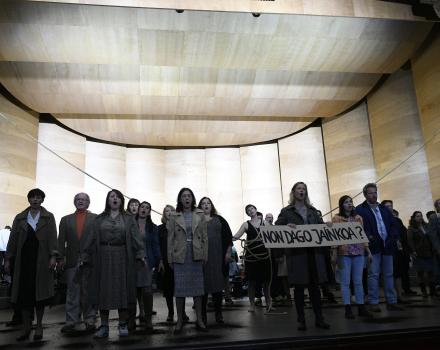

St John Passion

Bach's seminal work of sacred art paints a monumental fresco of life's journey to redemption. Calixto Bieito, one of the most exciting directors of his generation, directs this dramatised oratorio. With the help of an excellent cast, the period orchestra Les Talens Lyriques and a group of amateur singers which form the chorus at the heart of the narrative, he leads us into dialogue with this work today to confront pain and death.
Cast
Jesus | Benjamin Appl |
|---|---|
The Evangelist | Joshua Ellicott |
Sopranos | Lenneke Ruiten |
Alto | Carlos Mena |
Tenor / aria | Robert Murray |
Bass / Pilate | Andreas Wolf |
A female servant | Céline Boudineau* |
A male servant | Joseph Ben Zakoun* |
Pierre | Arnaud Keller* |
Chorus | Chœur de Paris |
Orchestra | Les Talens Lyriques |
| ... | |
Music | Johann Sebastian Bach |
|---|---|
Conductor | Philippe Pierlot |
Director | Calixto Bieito, revival by Lucía Astigarraga |
Sets | Aida-Leonor Guardia |
Lighting | Michael Bauer |
Costumes | Ingo Krügler |
Chorus Master | Till Aly |
Musical director assistant | Clément Lonca |
Costume designer assistant | Paula Klein |
| ... | |
Video
The story
The Passion narrative tells the story of Jesus' last hours, from his arrest to his burial.
The first part relates the betrayal of Judas and the denial of Peter. Peter lies three times, denying that he is Jesus' disciple. Immediately a cock crows, thus fulfilling the announcement made by Jesus a few days earlier.
The second part presents the face to face meeting with Pilate. This Roman, prefect of Judea, is pressed by the crowd and the priests to condemn Jesus. He tries to free him but ends up handing him over to them, although he sees no grounds for condemnation. On the cross on which Jesus is crucified, Pilate has the words ‘Jesus of Nazareth, King of the Jews’inscribed. Persecuted by soldiers (crown of thorns, sharing of clothes, sponging with vinegar), Jesus dies on the cross. A final blow from a spear to the side causes blood and water to gush out. Pilate allows Jesus' body to be carried away and wrapped in a shroud and then laid in a tomb.
To this biblical account, taken from Luther's translation of the Gospel of John, choruses are added which express the believers' passions and doubts or the fury of the crowd. A third voice, also sung by the choir, conveys the dogmatic thinking of the German Protestant community.
Insights
St John Passion as secular liturgy
Johann Sebastian Bach - now here’s a name you did not expect to see on OperaVision. Although he never wrote an opera, the German Baroque composer (1685-1750) often showed himself sensitive to the dramatic dimension of his liturgical repertoire. Some of his secular cantatas in particular display an almost operatic quality. He did not hesitate to call them ‘dramma per musica’ - Italian for drama for music -, the same term used to describe ‘opere serie’, the noble style of Italian opera popular throughout Europe at his time. All well and good, but that is still a long way from opera. Let us retrace the steps that lead to the Passion, conceived as functional church music that has hence become standard concert repertoire, being streamed on an opera platform today.
Bach worked again and again on the Johannespassion, from his first year as cantor of the church of Saint Thomas until shortly before his death. He experimented with it like he did with no other large-scale composition, creating several revisions over 25 years. That alone proves the importance the work holds in his oeuvre and in his heart. Premiered on Good Friday 1724 in the Lutheran Nikolaikirche (Church of Saint Nicolas) in Leipzig, the Passion’s structure is divided into two halves intended to accompany a sermon. The anonymous libretto draws on a mixture of different textual genres, including existing works as was the custom at the time. It consists of recitatives and choruses narrating the Passion of Christ as told in the Gospel of John, ariosi and arias commenting the action, and chorales based on hymns and texts familiar and easy to sing for the congregation.
This is where Théâtre du Châtelet’s production of St John Passion, co-produced with Teatro Arriaga in Bilbao, enters the picture. Right from the beginning, the Spanish director Calixto Bieito was determined to bring in amateur singers to form the chorus which is at the heart of the narrative: ‘In Bilbao, choral singing is a genuine tradition that goes back more than two centuries. (…) It was natural for me to make the chorus the centre of this secular, pagan and spiritual liturgy’. Known for his radical opera interpretations, Bieito had yearned to stage the Passion for many years. A dramatised oratorio was no contradiction in his mind, convinced that biblical texts are inclusive enough to be interpreted non-literally. ‘They reflect our desires, frustrations, fantasies and, most of all, they express our profound need to believe, in both the simplest and most complex sense of the term.’
The abstract scenic space Bieito creates forms an aesthetic contrast, which is only heightened by the use of contemporary costumes. Together they tell of his desire to recreate a secular liturgy for today. He produces a series of suggestive images and allegorical scenes depicting the countless victims claimed by the 20th and 21st centuries in Europe, beginning with the suffering of a single person and ending with a common grave. ‘Bach’s music offers a great opportunity to tackle the difficulty of our existences as well as the opacity of a system that oppresses its people. With Bach, we rediscover the fragility, beauty and cruelty of our time.’
Gallery










